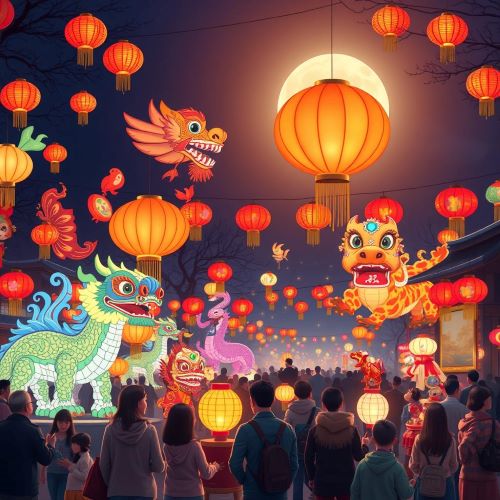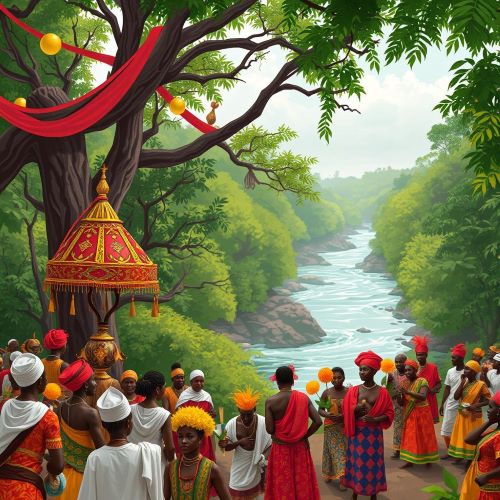Obon : Festival of the Dead
At a glance
| Description | |
|---|---|
| Location | Kyoto, Osaka, Tokyo |
| Country | Japan |
| Dedicated To | Ancestors |
| Duration | 3 days |
| Time of Year | August |
Introduction
Obon, also known simply as the Obon Festival, is one of Japan’s most heartfelt and spiritually significant traditions. Observed each year, Obon honors the spirits of ancestors who are believed to return to the world of the living for a brief reunion with their families. The festival blends solemn remembrance with joyous celebration, filling cities, towns, and villages across Japan with music, dance, and light. Rooted in both Buddhist and indigenous Japanese practices, Obon is a beautiful expression of love, gratitude, and the enduring ties that connect generations across time.
Connection with Mythology
The roots of Obon are deeply embedded in Buddhist mythology, particularly through the story found in the Ullambana Sutra. According to legend, Mokuren (also called Maudgalyāyana), a devoted disciple of the Buddha, used his spiritual insight to find his deceased mother trapped in the realm of hungry ghosts—a domain of suffering and endless craving. Distressed, he sought Buddha’s advice, who instructed him to offer food and prayers to monks returning from their summer retreat. By doing so, Mokuren liberated his mother’s spirit, a gesture that became the cornerstone of Obon’s practices.
Beyond this foundational myth, Japanese belief systems imbued Obon with the idea that ancestral spirits journey back to the world of the living during this time. Lanterns are symbolic tools to guide these spirits, lighting their path with hope and reverence. This mythological backdrop imbues the festival with a profound sense of purpose: a compassionate bridge between worlds, reminding families of the unseen, ongoing presence of their loved ones.
Main Activities
Obon unfolds over several days, each carrying its own customs and symbolism that beautifully balance reverence with community spirit.
Welcoming the Spirits (Mukae-bon) initiates the festival. Families visit cemeteries, meticulously cleaning gravestones and making offerings of flowers, incense, and food. At dusk, lanterns known as chōchin are hung at homes and graves, their warm glow intended to lead spirits home. In some regions, small fires called mukaebi are lit at the family’s doorstep to further guide and welcome ancestral souls.
The heartbeat of Obon is the Bon Odori dance, performed in parks, temples, and town squares. Participants don colorful yukata and dance around a central platform (yagura), moving to traditional folk songs that vary by region. Originally meant to welcome spirits with joy, Bon Odori today fosters a strong sense of community and shared heritage among participants.
As Obon draws to a close, families and communities partake in Sending Off the Spirits (Okuri-bon) rituals. Floating lanterns (toro nagashi) are released onto rivers, lakes, or seas, illuminating waterways in breathtaking scenes that symbolize guiding spirits back to their realm. In Kyoto, the famous Gozan no Okuribi bonfires blaze giant characters into the mountains, visible for miles, providing another striking farewell to the visiting ancestors.
Adding to these rituals, charming customs like crafting spirit horses—cucumber and eggplant animals representing swift arrivals and slow departures—add a creative and tender dimension to Obon’s traditions. The festival is also rich in seasonal treats like somen noodles and manju sweets, offered both to spirits and delighted festival-goers, weaving culinary joy into the spiritual fabric of Obon.
Importance in Cultural History
Obon holds a revered place in Japan’s cultural history, reflecting centuries of evolving spiritual and communal life. Dating back over 500 years, the festival has grown from a purely religious observance into a cherished national tradition that bridges old beliefs with contemporary life.
Historically tied to the lunar calendar, Obon’s timing was adapted to the solar calendar after Japan’s modernization in the late 19th century, resulting in regional variations with celebrations typically occurring in mid-July or mid-August. Despite these adjustments, the festival’s core essence of honoring ancestors remains unchanged.
Obon plays a crucial role in sustaining traditional arts and practices. Regional Bon Odori dances, once local expressions of faith and festivity, have been carefully preserved and passed down, ensuring the continuity of regional identities. Music, ceremonial attire, and craft-making associated with Obon keep ancient skills alive, embedding them naturally into the rhythm of modern Japanese society.
Beyond its tangible rituals, Obon reinforces essential values: the importance of family ties, community togetherness, and gratitude for those who came before. It is a living testament to how spirituality and daily life interweave in Japanese culture, offering both a reflective pause and a vibrant celebration.
Need a place to stay? Book your hotel room now!
International Appeal
While Obon’s roots are firmly planted in Japanese soil, its spirit has blossomed globally, carried abroad by Japanese immigrants and warmly embraced by international communities. In places like Hawaii, California, and parts of South America, Obon festivals are celebrated with remarkable enthusiasm, often featuring local interpretations of traditional practices. From Bon Odori performances in temple courtyards to colorful street festivals, these events keep cultural memories alive while forging new connections.
In Japan, Obon draws travelers from around the world eager to experience its magical atmosphere firsthand. The sight of river lanterns, the sound of taiko drums, and the taste of traditional festival foods create lasting impressions on visitors, offering a window into Japan’s profound cultural and spiritual traditions.
Moreover, Obon resonates on a universal level. Its themes—honoring ancestors, celebrating life’s continuity, and embracing the cycle of death and rebirth—echo traditions found in other cultures. Similar festivals like China’s Ghost Festival and Mexico’s Día de los Muertos show that the impulse to remember and celebrate the dead is a shared human experience. Obon, in this way, acts as a cultural bridge, connecting people across borders through shared reverence and joy.
Source
Bon Festival | Britannica. (n.d.). https://www.britannica.com/story/bon-festival
Agoda Travel Guides. (2025). Experience the Obon Festival: Japan’s Summer Magic Awaits » Agoda. https://www.agoda.com/travel-guides/japan/experience-the-obon-festival-japans-summer-magic-awaits/
Japanese Traditions: Obon. (2025). https://www.jcchawaii.org/resources/obon
Obon Festival | Traditional Kyoto. (n.d.). https://traditionalkyoto.com/culture/obon-festival/
Utah’s Obon Celebration | Utah Division Of Multicultural Affairs. (2024). https://multicultural.utah.gov/utahs-obon-celebration/








